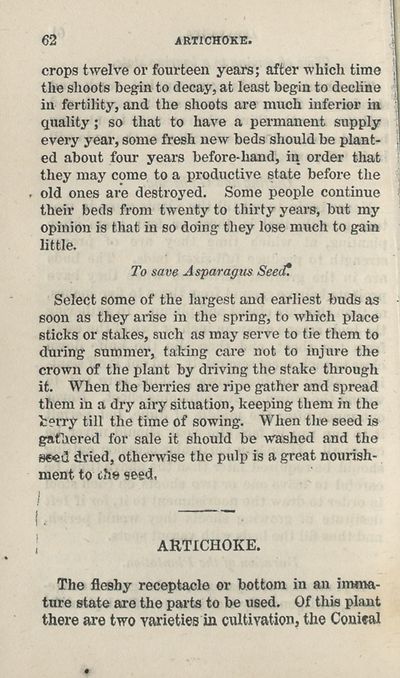Occupations > Abercrombie's improved practical gardener; with a monthly calendar for the flower garden
(66)
Download files
Complete book:
Individual page:
Thumbnail gallery: Grid view | List view

ARTICHOKE.
crops twelve or fourteen years; after which time
the shoots begin to decay, at least begin to decline
in fertility, and the shoots are much inferior in
quality; so that to have a permanent supply
every year, some fresh new beds should be plant¬
ed about four years before-hand, in order that
they may come to a productive state before the
old ones are destroyed. Some people continue
their beds from twenty to thirty yearn, but my
opinion is that in so doing they lose much to gain
little.
To save Asparagus See<£
Select some of the largest and earliest buds as
soon as they arise in the spring, to which place
sticks or stakes, such as may serve to tie them to
during summer, taking care not to injure the
crown of the plant by driving the stake through
it. When the berries are ripe gather and spread
them in a dry airy situation, keeping them in the
berry till the time of sowing. When the seed is
gathered for sale it should be washed and the
seed dried, otherwise the pulp is a great nourish¬
ment to th« seed,
ARTICHOKE.
The fleshy receptacle or bottom in an imma¬
ture state are the parts to be used. Of this plant
there are two varieties in cultivation, the Conital
crops twelve or fourteen years; after which time
the shoots begin to decay, at least begin to decline
in fertility, and the shoots are much inferior in
quality; so that to have a permanent supply
every year, some fresh new beds should be plant¬
ed about four years before-hand, in order that
they may come to a productive state before the
old ones are destroyed. Some people continue
their beds from twenty to thirty yearn, but my
opinion is that in so doing they lose much to gain
little.
To save Asparagus See<£
Select some of the largest and earliest buds as
soon as they arise in the spring, to which place
sticks or stakes, such as may serve to tie them to
during summer, taking care not to injure the
crown of the plant by driving the stake through
it. When the berries are ripe gather and spread
them in a dry airy situation, keeping them in the
berry till the time of sowing. When the seed is
gathered for sale it should be washed and the
seed dried, otherwise the pulp is a great nourish¬
ment to th« seed,
ARTICHOKE.
The fleshy receptacle or bottom in an imma¬
ture state are the parts to be used. Of this plant
there are two varieties in cultivation, the Conital
Set display mode to:
![]() Universal Viewer |
Universal Viewer | ![]() Mirador |
Large image | Transcription
Mirador |
Large image | Transcription
| Antiquarian books of Scotland > Occupations > Abercrombie's improved practical gardener; with a monthly calendar for the flower garden > (66) |
|---|
| Permanent URL | https://digital.nls.uk/121882011 |
|---|
| Description | Thousands of printed books from the Antiquarian Books of Scotland collection which dates from 1641 to the 1980s. The collection consists of 14,800 books which were published in Scotland or have a Scottish connection, e.g. through the author, printer or owner. Subjects covered include sport, education, diseases, adventure, occupations, Jacobites, politics and religion. Among the 29 languages represented are English, Gaelic, Italian, French, Russian and Swedish. |
|---|

